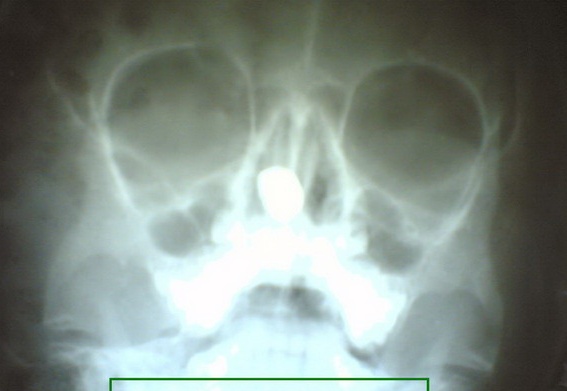Rhinolith
Editor-In-Chief: Prab R Tumpati, MD
Obesity, Sleep & Internal medicine
Founder, WikiMD Wellnesspedia &
W8MD medical weight loss NYC and sleep center NYC
| Rhinolith | |
|---|---|

| |
| Synonyms | N/A |
| Pronounce | N/A |
| Specialty | N/A |
| Symptoms | Nasal obstruction, nasal discharge, foul odor |
| Complications | Nasal septum perforation, sinusitis, epistaxis |
| Onset | Gradual |
| Duration | Chronic |
| Types | N/A |
| Causes | Calcification of foreign body in the nasal cavity |
| Risks | Presence of foreign objects in the nose, chronic rhinitis |
| Diagnosis | Nasal endoscopy, CT scan |
| Differential diagnosis | Nasal polyp, sinusitis, tumor |
| Prevention | N/A |
| Treatment | Surgical removal |
| Medication | Antibiotics if infection is present |
| Prognosis | Good with treatment |
| Frequency | Rare |
| Deaths | N/A |
Rhinolith is a stone present in the nasal cavity. The term is derived from the Greek words 'rhino' meaning nose and 'lith' meaning stone. Rhinoliths are rare and are often unilateral, affecting only one side of the nasal cavity. They can cause symptoms such as nasal obstruction, foul-smelling nasal discharge, and epistaxis (nosebleeds).
Causes[edit | edit source]
Rhinoliths are formed when mineral salts like calcium and magnesium phosphate deposit around a nidus (a central point or focus of bacterial activity) within the nasal cavity. The nidus can be either endogenous (originating within the body, such as a blood clot or a piece of bone) or exogenous (originating outside the body, such as a bead or a piece of cotton).
Symptoms[edit | edit source]
The symptoms of rhinoliths can vary depending on the size and location of the stone. Common symptoms include:
- Unilateral nasal obstruction
- Foul-smelling nasal discharge
- Epistaxis (nosebleeds)
- Facial pain
- Rhinorrhea (runny nose)
- Sinusitis
Diagnosis[edit | edit source]
Rhinoliths can be diagnosed through a physical examination and imaging studies. During a physical examination, a healthcare provider may be able to see the stone through the nostril. Imaging studies such as X-rays or computed tomography (CT) scans can help confirm the diagnosis and determine the size and location of the stone.
Treatment[edit | edit source]
The treatment for rhinoliths is surgical removal. This can be done through a simple outpatient procedure under local anesthesia. In some cases, a more extensive surgery may be required if the stone is large or if it has caused complications such as sinusitis or nasal polyps.
See Also[edit | edit source]
Search WikiMD
Ad.Tired of being Overweight? Try W8MD's physician weight loss program.
Semaglutide (Ozempic / Wegovy and Tirzepatide (Mounjaro / Zepbound) available.
Advertise on WikiMD
|
WikiMD's Wellness Encyclopedia |
| Let Food Be Thy Medicine Medicine Thy Food - Hippocrates |
Translate this page: - East Asian
中文,
日本,
한국어,
South Asian
हिन्दी,
தமிழ்,
తెలుగు,
Urdu,
ಕನ್ನಡ,
Southeast Asian
Indonesian,
Vietnamese,
Thai,
မြန်မာဘာသာ,
বাংলা
European
español,
Deutsch,
français,
Greek,
português do Brasil,
polski,
română,
русский,
Nederlands,
norsk,
svenska,
suomi,
Italian
Middle Eastern & African
عربى,
Turkish,
Persian,
Hebrew,
Afrikaans,
isiZulu,
Kiswahili,
Other
Bulgarian,
Hungarian,
Czech,
Swedish,
മലയാളം,
मराठी,
ਪੰਜਾਬੀ,
ગુજરાતી,
Portuguese,
Ukrainian
Medical Disclaimer: WikiMD is not a substitute for professional medical advice. The information on WikiMD is provided as an information resource only, may be incorrect, outdated or misleading, and is not to be used or relied on for any diagnostic or treatment purposes. Please consult your health care provider before making any healthcare decisions or for guidance about a specific medical condition. WikiMD expressly disclaims responsibility, and shall have no liability, for any damages, loss, injury, or liability whatsoever suffered as a result of your reliance on the information contained in this site. By visiting this site you agree to the foregoing terms and conditions, which may from time to time be changed or supplemented by WikiMD. If you do not agree to the foregoing terms and conditions, you should not enter or use this site. See full disclaimer.
Credits:Most images are courtesy of Wikimedia commons, and templates, categories Wikipedia, licensed under CC BY SA or similar.
Contributors: Prab R. Tumpati, MD

